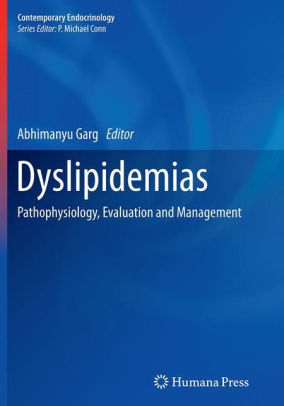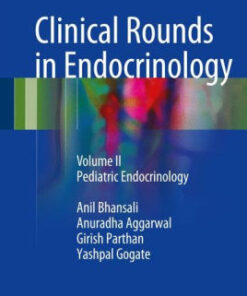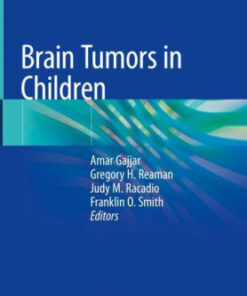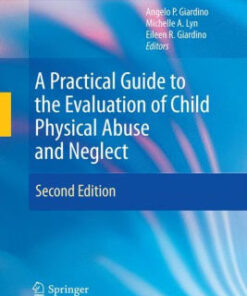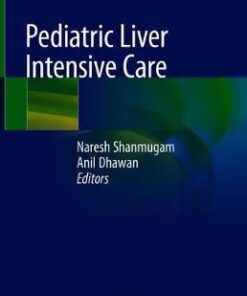(eBook) Dyslipidemias – Pathophysiology, Evaluation and Management By Abhimanyu Garg
$22.00
Download instantly Dyslipidemias – Pathophysiology, Evaluation and Management By Abhimanyu Garg. It is ebook in PDF format.
ISBN-10: 1607614235 ISBN-13: 9781607614234
Preview
This is the PDF eBook version for Dyslipidemias – Pathophysiology, Evaluation and Management By Abhimanyu Garg
Table of Contents
Chapter-1
Lipoprotein Physiology
Introduction
Physiology and Metabolism of ApoB-Containing Lipoproteins
The Intestine Mediates Absorption of Dietary Fat and Cholesterol and Synthesis of Chylomicrons Durin
The Liver Uses Adipose-Derived and De Novo Synthesized Fatty Acids for the Synthesis of VLDL
Physiology and Metabolism of HDL
HDL Biosynthesis and Production
HDL Cholesterol Esterification by LCAT
HDL CE Transfer by Cholesterol Ester Transfer Protein
HDL Remodeling by Lipases
Catabolism of HDL
Cholesterol Efflux and RCT
Other Properties of HDL
References
Chapter-2
Epidemiology of Blood Lipids and Lipoproteins
Introduction
Blood Lipids and Cardiovascular Risk
Metabolic Syndrome and Insulin Resistance
Apolipoproteins
Estimating Risk for CVD Outcomes
Mean Levels of Cholesterol Around the World
Summary
References
Chapter-3
Lipoprotein(a)
Lipoprotein(a) Structure and Properties
Physiological Properties
Lp(a) and Cardiovascular Disease
Regulation of Lp(a) Levels: Role of LPA Size Variability
Regulation of Lp(a) Levels: LPA Gene Nonsize Polymorphisms
Integrated Role of LPA Gene Size and Nonsize Polymorphisms
Factors Beyond the LPA Gene Impacting on Lp(a) Levels
Mendelian Randomization Studies and Lp(a)
Treatment and Intervention Options to Reduce High Lp(a)
Measurement of Lp(a)
Conclusion
Addendum
References
Chapter-4
Lipoproteins and Cardiovascular Disease Risk
Introduction
Total and LDL Cholesterol
HDL Cholesterol
Non-HDL Cholesterol
Apolipoproteins
Triglycerides
Controversy Between Guidelines for Risk Assessment
Concept of Residual Risk
References
Chapter-5
Detection and Treatment of Children and Adolescents with Dyslipidemia
Introduction
Disorders of Low-Density Lipoprotein Metabolism in Children and Adolescents Due to Altered LDL Recep
Familial Hypercholesterolemia
Familial Ligand-Defective apoB-100
Heterozygous FH3
Autosomal Recessive Hypercholesterolemia
Sitosterolemia
Cholesterol 7a-Hydroxylase Deficiency
Lysosomal Acid Lipase Deficiency
Wolman Disease and Cholesteryl Ester Storage Disease
Disorders of LDL Metabolism in Children and Adolescents Due to Overproduction of VLDL/IDL/LDL
Familial Combined Hyperlipidemia
Disorders of LDL Metabolism in Children and Adolescents Due to Decreased Production of VLDL/IDL/LDL:
Abetalipoproteinemia
Hypobetalipoproteinemia
Homozygous Hypobetalipoproteinemia
Chylomicron Retention Disease
Disorders of TG Metabolism in Children and Adolescents Due to Decreased Catabolism of TG-Rich Lipopr
Disorders of Exogenous Hypertriglyceridemia
Disorders of Endogenous Hypertriglyceridemia
Disorders of Endogenous and Exogenous Lipoprotein Transport Dysbetalipoproteinemia (Type III Hyperli
Familial Disorders of HDL Metabolism
Apolipoprotein A-I Mutations
LCAT Deficiency
Cholesteryl Ester Transfer Protein Deficiency
Scavenger Receptor Class B Type I Receptor Deficiency
Deficiency of Endothelial Lipase
Elevated Lp (a)
Guidelines for the Clinical Evaluation and Treatment of Dyslipidemia in Children and Adolescents
Expert Panel on Integrated Guidelines for Cardiovascular Health and Risk Reduction in Children and A
Pediatric “Metabolic Syndrome”
Screening for Dyslipidemia in Pediatrics
Guidelines for Treatment of Dyslipidemia in Children and Adolescents
Dietary Therapy
Treatment and Follow-Up with Dietary Treatment
Guidelines for Treatment of Dyslipidemia in Children and Adolescents
Pharmacological Therapy
HMGCoA Reductase Inhibitors (Statins)
Special Issues in Young Females
Bile Acid Sequestrants (BAS)
Cholesterol Absorption Inhibitor (CAI)
Niacin (Nicotinic Acid)
Fibrates
Fish Oils
Treatment of Dyslipidemia Secondary to Other Diseases [1–4]
Polycystic Ovary Syndrome
Summary
References
Chapter-6
Type 2 Diabetes Mellitus and Dyslipidemia
Introduction
Epidemiology
Dyslipidemia in Type 2 Diabetes
Prevalence of Dyslipidemia in Type 2 Diabetes
Dyslipidemia as a Predictor of CVD in Individuals with Type 2 Diabetes
Mechanisms Underlying the Association Between Dyslipidemia and Type 2 Diabetes
Alterations in Triglyceride-Rich Lipoprotein Particles in Type 2 Diabetes
Alterations in Lipoprotein Particles in Prediabetes
Type 2 Diabetes and Postprandial Lipemia
Efficacy of Lipid-Lowering Medication in Prevention of CVD in Patients with Type 2 Diabetes: Evidenc
Statins
Heart Protection Study
CARDS Study
ASPEN Study
Meta-analyses of CVD Risk Reduction with Statins/ Lipid-Lowering Treatment in Patients with Type 2 D
The Diabetogenic Potential of Statin Treatment
Fibrates
FIELD
ACCORD
Meta-analyses of Fibrate Trials
Other Lipid Lowering Treatments
Conclusions from Trial Evidence
Guidelines for Lipid-Lowering Treatment
Concluding Remarks
References
Chapter-7
Type 1 Diabetes Mellitus and Dyslipidemia
Introduction
History
Epidemiology
Etiology and Pathogenesis
Classification and Goals
Clinical Findings
Approach to the Patient
Physical Findings
Laboratory Tests
Differential Diagnosis
Complications
Prognosis and Clinical Course
Treatment
Conclusion
References
Chapter-8
Dyslipidemia in Chronic Kidney Disease and Nephrotic Syndrome
Introduction
Part I: Lipid Disorders in Nephrotic Syndrome
Pathogenesis of Nephrotic Dyslipidemia
Part II: Lipid and Lipoprotein Metabolism in Chronic Renal Failure
Abnormalities of Triglyceride-Rich Lipoprotein Metabolism in CKD
Effect of CKD on Cholesterol and LDL Metabolism
HDL Abnormalities in Chronic Renal Failure
Lp(a) in CKD
Part III: Superimposing Factors that Modify Lipid Metabolism in CKD/ESRD
Part IV: Treatment of Dyslipidemia in Patients with Kidney Disease
Statins
Fibrates
Niacin
Experimental Lipid-Modulating Agents (ACAT Inhibitors)
References
Chapter-9
Dyslipidemia in HIV-Infected Patients
Introduction
Dyslipidemia Associated with HIV Viraemia
Observations in HIV-Infected, Treatment-Naïve Populations
Mechanisms of Dyslipidaemia Associated with HIV Viraemia
Dyslipidaemia Associated with ART
HIV Lipodystrophy and Dyslipidaemia
Data from Clinical Trials: 1996 to the Present
ART-Associated Dyslipidemia: The Risk and Clinical Relevance
Management of HIV-Associated Dyslipidemia
Diagnosis and Evaluation
Management Approach
Switching ART
Statin Therapy
Other Hypolipidaemic Agents
Conclusions
References
Chapter-10
Monogenic Hypercholesterolemias
Definition and Classification
Familial Hypercholesterolemia
Etiology and Pathogenesis
The LDLR Gene
APOB Gene
Proprotein Convertase Subtilisin/Kexin Type 9 Gene
Other FH Loci
Clinical Findings
FH Diagnosis
Lipid-Lowering Therapy for Heterozygous FH
Homozygous FH Treatment
Autosomal Recessive Hypercholesterolemia
Lysosomal Acid Lipase Deficiency
Cholesterol-7-Alpha-Hydroxylase Deficiency (OMIM 118455)
Summary
References
Chapter-11
Primary Hypertriglyceridemia
Introduction
“Familial” Does Not Mean Monogenic
Clinical Diagnosis of HTG
Classification of HTG Phenotypes
Secondary Factors Contributing to HTG
Monogenic HTG: Familial Chylomicronemia (Formerly Known as HLP Type 1)
Polygenic HTG: Common Genetic Basis for Complex HTG Phenotypes
Simple Primary Hypertriglyceridemia (HLP Type 4)
Dysbetalipoproteinemia (HLP Type 3)
Mixed Hyperlipidemia (HLP Type 5)
Combined Hyperlipidemia (HLP )Type 2B)
General Treatment Approaches for HTG (Tables 11.4 and 11.5)
Nonpharmacological Treatment
Fibrates
Nicotinic Acid (Niacin)
Statins
Omega-3 Fatty Acids
Conclusion
References
Chapter-12
Genetic Disorders of HDL Metabolism
Introduction
HDL Structure and Metabolism
Low HDL-C Syndromes
Tangier Disease
Familial LCAT Deficiency/Fish-Eye Disease
ApoAI Deficiency
Familial Combined Hypolipidemia
Familial Combined Hyperlipidemia
Secondary Causes of Low HDL-C
Genetic Causes of High HDL-C Levels
CETP Deficiency
Primary Hyperalphalipoproteinemia
Familial Hepatic Lipase Deficiency
Familial Hyperalphalipoproteinemia Associated with Variant apoCIII
Endothelial Lipase Deficiency
SR-BI Deficiency
Clinical Challenges with HDL Therapeutics
Conclusions
References
Chapter-13
Sitosterolemia and Other Rare Sterol Disorders
Introduction
Sterol Trafficking Disorders
Sitosterolemia/Phytosterolemia
History
Epidemiology
Etiology and Pathogenesis
Clinical Findings
Laboratory Tests
Differential Diagnosis
Complications
Clinical Course and Treatment
Sterol Synthesis Disorders
Smith–Lemli–Opitz Syndrome
History
Epidemiology
Etiology and Pathogenesis
Clinical Findings
Laboratory Tests
Differential Diagnosis
Clinical Course and Treatment
Sterol Breakdown Disorders
Cerebrotendinous Xanthomatosis
History
Epidemiology
Etiology and Pathogenesis
Clinical Findings
Laboratory Tests
Differential Diagnosis
Clinical Course and Treatment
References
Chapter-14
Genetic Abetalipoproteinaemia and Hypobetalipoproteinaemia
Introduction
History
Epidemiology
Etiology and Pathogenesis
Abetalipoproteinaemia
Familial Hypobetalipoproteinaemia
Chylomicron Retention Disease
Other Molecular Causes of Hypobetalipoproteinaemia
Classification
Clinical and Physical Findings
Abetalipoproteinaemia
Familial Hypobetalipoproteinaemia
Chylomicron Retention Disease
Approach to the Patient
Laboratory Tests
Molecular Tests
Differential Diagnosis
Prognosis, Clinical Course, and Complications
Abetalipoproteinaemia and Homozygous Familial Hypobetalipoproteinaemia
Heterozygous Familial Hypobetalipoproteinaemia
Chylomicron Retention Disease
Treatment
Abetalipoproteinaemia
Familial Hypobetalipoproteinaemia
Chylomicron Retention Disease
Conclusion
References
Chapter-15
Drug-Induced Dyslipidemia
Introduction
Antihypertensives
Beta-Adrenergic Blockers
Diuretics
Steroid Hormones
Glucocorticoids
Estrogen and Related Compounds
Androgens
Immunosuppressive Drugs
Cyclosporine
Sirolimus
Antineoplastic Agents
Retinoids
Interferons
L-Asparaginase
Capecitabine
Atypical Antipsychotics
Antiepileptic Drugs
Propofol
Protease Inhibitors
Conclusions
References
Chapter-16
Lipodystrophies and Dyslipidemias
Introduction
Overview of Lipodystrophy Syndromes
Genetic Lipodystrophies
Congenital Generalized Lipodystrophy
Familial Partial Lipodystrophy
Lipodystrophy in Association with Other Syndromes
Acquired Lipodystrophies
Acquired Generalized Lipodystrophy (Lawrence Syndrome)
Acquired Partial Lipodystrophy (Barraquer–Simons syndrome)
Highly Active Antiretroviral Therapy-Induced Lipodystrophy in HIV-Infected Patients
Hyperlipidemia in Lipodystrophy Syndromes
Mechanisms of Fat Loss and Dyslipidemia in Generalized Lipodystrophy
Mechanisms of Fat Loss and Dyslipidemia in Partial Lipodystrophy
Therapeutic Options for Dyslipidemias in Lipodystrophies
Conclusions
References
Chapter-17
Novel Genes for Dyslipidemias: Genome-Wide Association Studies
Introduction
A Primer on Genome-Wide Association Studies
GWAS on Blood Lipid Traits
Novel Genes That Have Emerged from GWAS
Conclusion
References
Chapter-18
Perspectives on Cholesterol Guidelines
Secondary Prevention
Clinical Trial Evidence in Secondary Prevention
LDL-C Goals
Other Lipid Targets
Secondary Prevention Without Specific Lipid-Lowering Goals
Combination Drug Therapy in Secondary Prevention
LDL-Lowering Therapies Under Development
Lifestyle Therapy in Secondary Prevention
Treatment of Hypertriglyceridemia in Secondary Prevention
Primary Prevention
Risk Assessment: Selection of Patients for Drug Treatment
LDL-C Goals in Primary Prevention
Statin Therapy Without LDL-Cholesterol Goals in Primary Prevention
When to Start Drug Therapy in Primary Prevention
Non-Statin Drugs in Primary Prevention
Lifestyle Intervention for Primary Prevention
References
Chapter-19
Nutrition and Coronary Heart Disease Prevention
I. National Guidelines
A. US Dietary Guidelines
B. New Guidelines from the American College of Cardiology and the American Heart Association
II. Justification for Dietary Recommendations
A. Controlled Metabolic Studies
B. Population Studies
C. Dietary Intervention Studies
C1. Oslo Diet Heart Studies
C2. Los Angeles Veterans Administration Study
C3. Finnish Mental Hospital Study
C4. Minnesota Mental Hospital Study
C5. The Lyon Diet Heart Trial
C6. The Women’s Health Initiative
C7 Diet Atherosclerosis Treatment Trials
C8 Gruppo Italiano per lo Studio della Soppravvivenza nell’Infarto miocardico (GISSI)-Prevenzione
C9 Japan Eicosapentaenoic Acid Lipid Intervention Trial
C10. Alpha Omega Trial
C11. Primary Prevention of CVD with a Mediterranean Diet
C12. Conclusions from Dietary Interventions Trials
References
Chapter-20
Phytosterol Therapy
What Are Phytosterols?
Introduction to Cholesterol-Lowering Mechanism of Action of Phytosterols
Influence of Phytosterols in the Small Intestinal Lumen
Sterol Transporter Proteins and Dietary Phytosterols
TICE Pathway
Effects on Serum Lipids
Combination Therapy
Phytosterol Therapy and Atherosclerotic Cardiovascular Diseases
Safety
References
Chapter-21
N-3 Fatty Acids: Role in Treating Dyslipidemias and Preventing Cardiovascular Disease
Introduction
Overview of n-3 FAs
History and Development of n-3 FAs for Pharmacologic Use
Mechanism of Action
General Pharmacodynamic Effects on Lipids
Indications and Dosing Regimen
Risks and Precautions
Effects of n-3 FAs on TGs <?500 mg/dL
Effect of Long-Chain n-3 FAs on Lipoproteins and Apo CIII
Differential Effects of EPA Versus DHA on Lipids and Lipoproteins
Impact of Genotype on Lipid Effects of n-3 FAs
Efficacy of Long-Chain n-3 FAs in Preventing Coronary Heart Disease
Conclusions
References
Chapter-22
Polyphenols for Cholesterol Management
Introduction
History
Chemical Structure
Phenolic Acids
Flavonoids
Stilbenes
Lignans
Effects of Polyphenols on Lipid and Lipoprotein Metabolism
Flavonoids
Trans-resveratrol
Catechins and Isoflavones
Effects of Polyphenols on Endothelial Function
Flavonoids
Trans-resveratrol
Polyphenol Metabolism
Flavonoids
Trans-resveratrol
Dosing Regimen and Adverse Effects
Conclusions
References
Chapter-23
Dietary Supplements for Cholesterol Management
Introduction
Red Yeast Rice
Soluble Dietary Fiber (SDF)
Nuts
Flaxseed
Soy Protein
Garlic
Berberine
Guggul
Policosanol
Artichoke Leaf Extract
Conclusions
References
Chapter-24
Statins: Risk Benefits and Role in Treating Dyslipidemias
Introduction
History
Chemical Structure
Mechanism of Action
Pharmacodynamics
Indications
Dosing Regimen
Risks and Precautions
Adverse Effects
Drug Interactions and Compatibilities
Clinical Trials
Conclusion
References
Chapter-25
Fibrates: Risk Benefits and Role in Treating Dyslipidemias
Introduction
History of Fibrates
Mechanism of Action of Fibrates
Pharmacology
Effects of Fibrates
Pharmacokinetics
Effect on Lipid Profiles
Effect on Clinical Outcomes
Effects in the “General” High-Risk Population
Effects in People with High TG and Low HDL Cholesterol
Effects in Diabetes
Effects in Chronic Kidney Disease
Combination Therapy
Risk (Safety and Tolerability of Fibrates)
Elevation of Serum Creatinine
Rhabdomyolysis, Creatine Kinase Elevations, Myopathy
Elevated Risk of Non-Cardiovascular Mortality
Other Adverse Effects
Elevation of Homocysteine
Conclusion
References
Chapter-26
Niacin: Risk Benefits and Role in Treating Dyslipidemias
Introduction
History
Mechanism of Action
Pharmacodynamics
Indications
Dosing Regimens
Risks and Precautions
Clinical Trials
Role of Niacin in Atherosclerotic Risk Reduction
References
Chapter-27
Bile Acid Sequestrants: Risk–Benefits and Role in Treating Dyslipidemias
Introduction
History of Bile Acid Sequestrants
Characteristic Features of BAS
Effects of BAS on Cardiovascular Events
Effects of BAS on Carbohydrate Metabolism
Role of BAS in the Context of Current Cholesterol Guidelines
Adverse Effects Associated with BAS
Concluding Remarks
References
Chapter-28
Cholesterol Absorption Inhibitor Ezetimibe: Risk–Benefits and Role in Treating Dyslipidemias
Introduction
History of Ezetimibe
Structure, Function, and Regulation of NPC1L1
Mechanisms of Intestinal Cholesterol Absorption and Chylomicron Synthesis
Absorption, Metabolism, and Pharmacodynamics of Ezetimibe
Effects of Ezetimibe on Lipid Metabolism and Mechanisms for Its Action
Molecular Mechanisms for Ezetimibe-Induced Inhibition of Cholesterol Absorption
Effects of Ezetimibe on Lipoprotein Metabolism
Ezetimibe Monotherapy
Mechanisms for Reduction of Serum LDL-C Levels (Fig. 28.3)
Ezetimibe in Combination with Statins and Other Lipid-Lowering Drugs
Reduction of Serum TG Levels and Increase of Serum HDL-C Levels by Ezetimibe
Inhibition of Absorption of Plant Sterols
Inhibition of Absorption of Oxidized Cholesterol
Ezetimibe Attenuates Postprandial Hyperlipidemia
Effects of Ezetimibe on Atherosclerosis in a Variety of Animal Models
Effect of Ezetimibe on NAFLD in Human Studies
Potential Therapeutic Targets of Ezetimibe
Dosing Regimen
Risks and Precaution
Prescribing Information
Drug Interactions and Compatibilities
Clinical Trials for Prevention of Atherosclerotic Cardiovascular Disease (CVD)
Ezetimibe and Simvastatin in Hypercholesterolemia Enhances Atherosclerosis Regression (ENHANCE) Tria
Simvastatin and Ezetimibe in Aortic Stenosis Trial (ClinicalTrials.gov, NCT00092677)
Stop Atherosclerosis in Native Diabetics Study (SANDS) Trial (ClinicalTrials.gov, NCT00047424)
The Study of Heart and Renal Protection Trial (ClinicalTrials.gov, NCT00125593, and ISRCTN54137607)
Arterial Biology for the Investigation of the Treatment Effects of Reducing Cholesterol 6-HDL and LD
Ongoing Clinical Trials
Conclusion
Disclosures
References
Chapter-29
Low-Density Lipoprotein (LDL) Apheresis
Introduction
History of LDL Apheresis
LDL Apheresis Availability
FDA Approved Indications for LDL Apheresis
Non-FDA-Approved Indications for LDL Apheresis
Lipoprotein(a)
Lipoprotein X
Type III Hyperlipidemia
Focal Segmental Glomerulosclerosisand Minimal Change Nephrotic Syndrome
Sudden Hearing Loss
Refsum Disease
LDL Apheresis Procedures
Plasmapheresis
Cascade Filtration
Dextran Sulfate Adsorption LDL Apheresis (Liposorber)
Heparin Extracorporeal LDL Precipitation Apheresis
Immunoadsorption LDL Apheresis (Therasorb LDL-Excorim)
Immunoadsorption Lp(a) Apheresis (Lp(a)-Excorim Lp(a) Lipopak)
Polyacrylamide Adsorption (DALI)
Benefits of LDL Apheresis
Conclusion
References
Chapter-30
Novel Lipid-Lowering Agents
Introduction
Future Therapies
Gene Therapy
Lipoprotein Lipase Gene Therapy
Drugs That Reduce Synthesis or Secretion of Lipids and Lipoproteins
Apolipoprotein B Synthesis Inhibitors
Microsomal Triglyceride Transfer Protein Inhibitors
Diacylglycerol O-acyltransferase 1 Inhibitors
ETC-1002
Drugs That Increase Clearance of Lipoproteins
Liver-Specific Thyroid Agonists
PCSK9 Inhibition
Drugs That Affect LPL Activity
Therapies That Affect HDL-C
Cholesteryl Ester Transfer Protein Inhibitors
Augmentation of Lipid-Poor APOA1
Conclusions
References
Reviewers
Index
